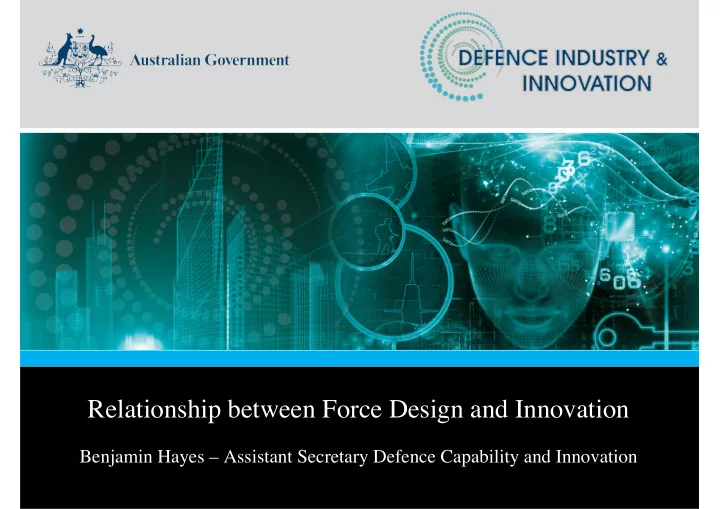

Relationship between Force Design and Innovation Benjamin Hayes – Assistant Secretary Defence Capability and Innovation
Strategic Drivers of the Defence Industry Policy The 2016 Defence White Paper set out Australia’s strategic challenges and outlines the policy and capability response, supported by the Integrated Investment Program and Defence Industry Policy Statement.
Defence Innovation Hub – Policy Objectives • Manage portfolio of innovation investment that is coherent and aligned with strategic priorities for Defence capability • Build capability and capacity of Australian defence industry and innovation sector • What is different? • Pathway to acquisition • How do we do that? • Force Design and Defence Capability Assessment Program drive investment priorities and focus • Gaps and Opportunities analysis – focused on Defence missions and linked to strategy
Industry & Innovation Embedded in Force Design Process Defence Industry & Innovation
Force Design Process and Defence Innovation • How do we know where to focus our investment in innovative ideas? • The Force Design Process identifies capability gaps and opportunities for referral to the Defence Innovation System • The Defence Innovation System is an important tool in identifying innovative solutions to these gaps and opportunities • Investment priorities identified by the Force Design Process are communicated to industry and research organisations through the Defence Innovation Hub • Approach to market: Call for Submissions, and Special Notices
Force Design Process and Defence Innovation • The new Defence Innovation System is a key mechanism for addressing some gaps and opportunities • Treatment/response options include: • Changes to the high-level innovation investment priorities • Amendments to the narratives that support the Defence Innovation Hub open solicitation • Special Notice solicitation framed around a problem/challenge • Adjustment to annual priorities for the Defence Material Technology Centre as set by the Defence Innovation Hub • Referral to a specific program element within the Next Generation Technologies Fund
Defence Innovation Investment Priorities Investment priorities are aligned with the six capability streams. Top three priorities for FY 2017-18: 1. Intelligence, Surveillance, Reconnaissance, Electronic Warfare, Space and Cyber 2. Key Enablers 3. Land Combat and Amphibious Warfare • Tweaks to FY 2017-18 priorities as a result of the gaps and opportunities analysis: • ISREW Space and Cyber – increased focus on ISREW enabling Joint Decision Support, Cyber and Joint Capability Edge • Key Enablers – addition of Autonomous Identification Technologies • Land Combat and Amphibious Warfare – increased focus on Special Operations
Before Gaps and Opportunities Analysis – Proportion of Defence funding spent on each capability stream Figure: Current Commitment Forecast by Capability Stream – Active Projects, current state not meeting our strategic objectives
After Gaps and Opportunities Analysis – Proportion of Defence funding spent on each capability stream Figure: Pipeline Contract Value by Capability Stream as at 6 October 2017 – 35.5% of submissions align with number 1 innovation priority area showing that market signalling is working
Special Notices • The Defence Innovation Hub commenced a Special Notice pilot program in June 2017, seeking proposals for two specific challenges: • Next Generation Wireless Environment • Man-portable Small Unmanned Aerial System of the Future • A Special Notice aims to: • Provide a vehicle to allow Defence business units to define a problem to the market to be addressed under a tailored approach to market; • Allow industry to provide innovative solutions to capability challenges that would otherwise go unnoticed; and • Leverage the innovative capacity of a wide spectrum of Australian business to solve the problem rather than only established Defence centric businesses.
Defence Innovation Hub: Up and Running since 5 December 2016 • Working hand in glove with Capability Managers • Very positive feedback from Defence and industry stakeholders 01 02 03 04 05 1159 365 108 17 contracts Specialist registered innovation RFP signed, over advisory users proposals issued $20m in team submitted investment established As at 6 Oct 17
Continuous I mprovement • Initial Operating Capability – 5 December 2016 ➢ Single innovation pipeline ➢ Clear, transparent priorities for investment ➢ Open solicitation, unique continuous assessment model ➢ Bespoke, modular contracting suite ➢ Innovation-friendly approach to Intellectual Property ➢ New digital marketplace and ICT system ➢ New governance arrangements ● coherent investment ● aligned to strategy ● pathway to acquisition
Continuous I mprovement • Final Operating Capability? No ➢ Continually add capability and sophistication to model (but not complexity) ➢ 10 year program • Things we are working on (or thinking about)… ➢ Special Notice capability ➢ Collaboration model ➢ Pitch / demo days ➢ IT upgrades (huge potential) ➢ Communities of interest ➢ Co-investment • Potential is enormous and exciting
Thank you
Recommend
More recommend